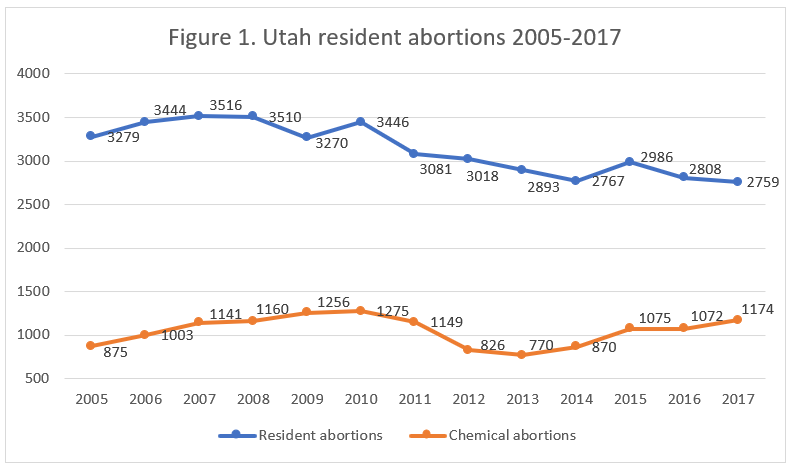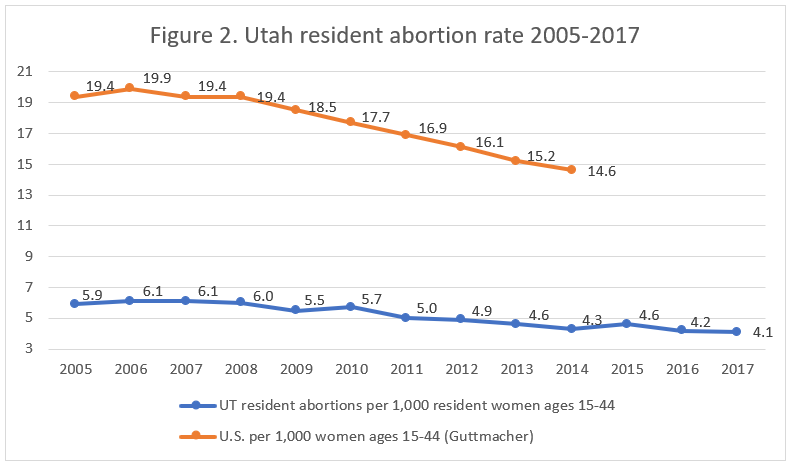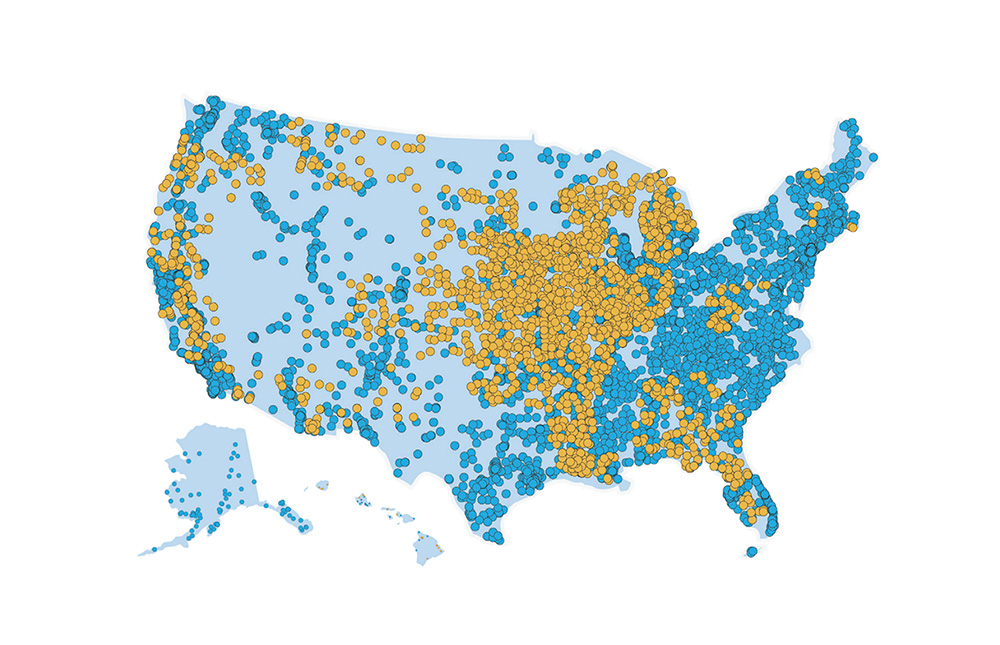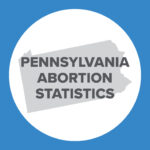Abortion Reporting: Utah (2017)

Utah’s 2017 abortion report, published by the Utah Department of Health in January 2019, reveals that reported abortions in the Beehive State reached their lowest level in over 40 years. Utah has been reporting abortion data since 1974.
Changes in Utah Abortions, 2016-2017

*The changes in total and chemical abortions reflect abortions performed on Utah residents only, rather than all abortions performed in the state. Information on Planned Parenthood’s Utah market share is not publicly available.
Abortion Totals and Trends
In 2017, there were 2,923 abortions reported in Utah, the lowest number reported since 1976. Utah abortions have fallen by 41 percent since 1989, the year the most abortions were reported in the state. From 2016, total Utah abortions have declined by three percent. Most of the information in Utah’s state report is for abortions performed on state residents; abortions performed in Utah on Utah residents declined by two percent from 2,808 in 2016 to 2,759 in 2017. At the same time, chemical abortions performed on Utah residents climbed 10 percent from 1,072 in 2016 to 1,174 in 2017. Since 2001, chemical abortions in Utah have risen by 161 percent. Chemical abortions made up 43 percent of all resident abortions in 2017. Utah’s resident abortion rate dropped slightly from 4.2 in 2016 to 4.1 in 2017.
State Report Summary
A large majority of the abortions reported in Utah, 94 percent, were performed on state residents. Demographic and medical information in Utah’s abortion report is for abortions performed on Utah residents only.
As in other states, more than half of the abortions were performed on women in their twenties (57 percent). Women in their thirties made up the next-largest age group at 27 percent. Twelve percent of the abortions were performed on women under the age of 20, and four percent were performed on women age 40 or older. White women were in the majority, accounting for 63 percent of reported abortions. Abortions performed on Hispanic women were reported as a separate racial category, rather than an ethnicity; in 2017, 22 percent of the abortions were performed on Hispanic women. Four percent of the abortions were performed on black women, two percent on Asian women, and one percent on Native American women. Eight percent of reported abortions were performed on women of unknown race.
Most of the resident women who got abortions in Utah had completed high school (42 percent) or even more education (51 percent). Just five percent had not finished high school. Level of education was not reported for one percent of the women. Twenty-three percent of the women were married, while 74 percent were unmarried – a lower percentage than in most other states, as the Charlotte Lozier Institute has noted. Marital status of the mother was not reported for three percent of the abortions.
More than half of the abortions were performed on resident women with no previous live births (57 percent), and more than three quarters were performed on women with no previous abortions (78 percent). Seventeen percent of the women had one previous live birth, and 14 percent had one previous abortion. Twenty-four percent of the abortions were performed on women with two or more live births and six percent on women with two or more prior abortions. The number of previous live births was unknown for three percent of the women, and the number of prior abortions was not reported for two percent.
Well over a third (39 percent) of the abortions performed on Utah residents occurred at six weeks of gestation or earlier. Thirty-one percent occurred between seven and eight weeks of gestation, and 13 percent were performed between nine and 10 weeks. Eight percent were performed between 11 and 12 weeks and three percent between 13 and 14 weeks. Five percent of the abortions were performed between 15 and 20 weeks of gestation. Twenty-one abortions were performed at 21 weeks of gestation or later—more than halfway through pregnancy, when babies can feel pain. Utah prohibits abortions after viability unless the mother’s life or physical health is in danger, the baby has a fatal abnormality, or the pregnancy resulted from rape or incest.
As in previous years, the vast majority of abortions—89 percent—were performed for “therapeutic” reasons. While the 2017 Utah report does not define what constitutes “therapeutic” or “elective” abortions – two separate reasons listed in the report – older reports do, as the Charlotte Lozier Institute has pointed out. The report for the years 1974-1977 states that the “therapeutic” option combined the older categories of “psychiatric” and “emotional distress.” Seven percent of the abortions were characterized as elective, and one percent were performed due to fetal abnormalities. Just 21 abortions were performed because the mother’s life was in danger, and none were performed due to an HIV-positive status. Two percent of the abortions were performed for unstated reasons. Of the 21 abortions performed after 20 weeks, 10 were therapeutic, another 10 were because of fetal abnormalities, and one was performed for an unknown reason. Seven abortions were known to have resulted in complications in 2017.1
Two-thirds of the women did not report their contraception history. Of those who did report this information, 20 percent used contraceptives sometime in the previous year, while 80 percent did not. Not quite one percent of the women undergoing abortions stated that the pregnancy was due to the omission of contraception. Six percent stated that their pregnancies did not result from the omission of contraception, and 93 percent did not provide an answer. Oral contraception was the most commonly reported method, used by 82 women.
Utah reports abortion occurrence by month. March had most resident abortions (268), while December had the fewest (200). On average, there were 230 abortions a month.
Protecting Life in Utah
Utah recently passed two laws that extend additional protections to unborn children. One law limits abortion after 18 weeks of gestation unless the mother’s life or a significant bodily function is in danger, the baby has a fatal abnormality, or the pregnancy was caused by rape or incest.
A second law prohibits abortions performed simply because the unborn child has Down Syndrome. The law will only go into effect when a court decides that states have the authority to prohibit the abortion of babies with Down Syndrome before the babies can live outside the womb. As of February 2019, four states had passed laws protecting unborn babies with Down Syndrome: Indiana, Ohio, North Dakota, and Louisiana. A lawsuit over Indiana’s law is pending before the Supreme Court, and Ohio’s case has been appealed in the Sixth Circuit. CLI legal scholar Tom Messner argues that there is a strong legal case to be made for the constitutionality of these antidiscrimination laws.
State Ranking
Utah’s abortion reporting was ranked at sixth place by CLI’s 2016 study of abortion reporting across the 50 states, the District of Columbia, and New York City. However, Utah could improve its reporting by including information on its informed consent and parental consent processes. Utah could report information for all abortions performed in the state, not just those undergone by Utah residents. Utah could also report the physical characteristics of the unborn children killed by abortion and whether any of the babies were viable – data points that are particularly relevant as Utah considers its two abortion bills. A 2014 Pew survey found that more than half of Utah adults say that abortion should be illegal in all or most cases; improved abortion reporting would give Utahns a better understanding of abortion occurrence in their state.


- Statistics on abortion complications reported here represent a minimal number of deaths and complications, as this data is collected in a non-systematic and non-verifiable way. As such, this data cannot be used to calculate either an accurate abortion mortality rate, nor an accurate abortion complication rate for the state.






















